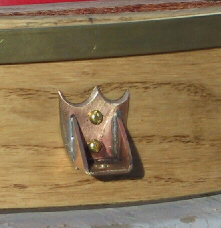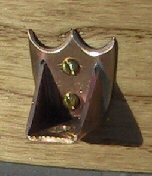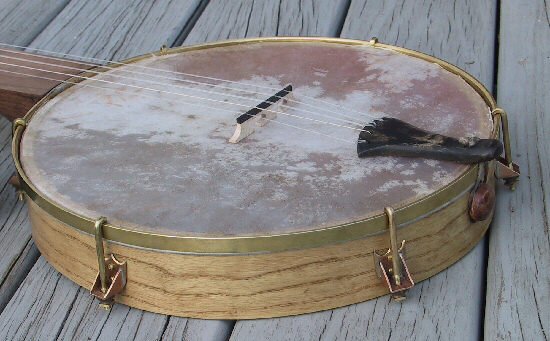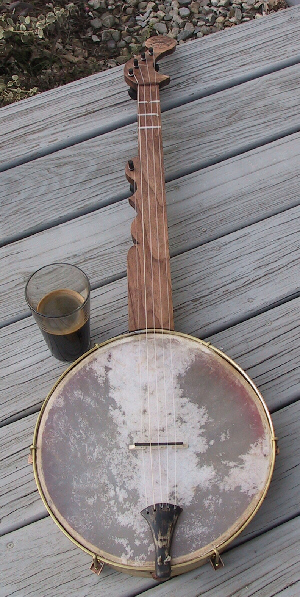After the head shrunk so much
it ripped out the tacks twice I had to face the fact that I needed to come
up with another way to fasten the head on to the banjo  or
I was going to go broke buying new
or
I was going to go broke buying new  heads.
I considered ordering a set of shoes from Elderly
Music but I was intrigued by the federal shield bracket shoes that
Eric Hector described from one of George Wunderlich's banjos. I couldn't
find a picture of them so I sort of improvised on my own and came up with
these out of heavy sheet brass.
heads.
I considered ordering a set of shoes from Elderly
Music but I was intrigued by the federal shield bracket shoes that
Eric Hector described from one of George Wunderlich's banjos. I couldn't
find a picture of them so I sort of improvised on my own and came up with
these out of heavy sheet brass.
The original wooden hoop (pot) ended up getting pulled
out of shape by the hide as it continued to shrink and tug where it was
still tacked down. I made a new hoop out of a slightly thicker piece of
ash. At Mac Steel in Rutland I managed to get a piece of 3/8 x 1/8 brass
for the ring. (Mac Steel is also where I got the cast iron
pipe for a hoop mold. Thanks, Josh!) I thought it would be too heavy but it seemed to be just
right by the time I finished with it. (I tapered the inside top by hand with a
file.) I scarfed the ends with about a 1
inch long taper and silver soldered them together. I considered riveting
them for good measure but this seemed to hold. I could have bent the brass
by hand but it was handy having a set of tinsmithing rolls to do it nice
and even. The wire hoop is galvanized 12 gauge steel wire and I soldered
a short sleeve of brass tubing from a hobby shop over the joint where the
ends butt together. Next time I will make the ring and hoop just a tad
larger as it was a tight struggle pulling the wet hide through. Elderly
sent a set of directions with their hides but I found a modified set in
Dr.
Horsehair's instruction book to be more understandable.
 I
had already ordered a calf-skin head from Elderly
Music (because of new regulations to prevent mad cow disease Yendor was
having trouble getting African goat skins) as well as some banjo hooks and nuts,
a bridge and a bone nut. I needed to extend the threads on the hooks but
discovered that the 8-26 thread was an odd size that I could not easily find a
die for so I also got some brass stock for the hooks at Mac Steel. I bent them
over, did a little grinding and filing, then threaded them. For the nuts I used
standard brass knurled nuts and I filed one end of them square. I saw a picture
of an original banjo that had nuts that looked like these but I do not know if
these nuts were original.
I
had already ordered a calf-skin head from Elderly
Music (because of new regulations to prevent mad cow disease Yendor was
having trouble getting African goat skins) as well as some banjo hooks and nuts,
a bridge and a bone nut. I needed to extend the threads on the hooks but
discovered that the 8-26 thread was an odd size that I could not easily find a
die for so I also got some brass stock for the hooks at Mac Steel. I bent them
over, did a little grinding and filing, then threaded them. For the nuts I used
standard brass knurled nuts and I filed one end of them square. I saw a picture
of an original banjo that had nuts that looked like these but I do not know if
these nuts were original.
 Well,
here it is now out on the front porch - just in time for spring. As I sit on the
porch, banjo in my lap I let the afternoon sunshine warm my knees and my feverish little
brain is getting ready for my next project ...
Well,
here it is now out on the front porch - just in time for spring. As I sit on the
porch, banjo in my lap I let the afternoon sunshine warm my knees and my feverish little
brain is getting ready for my next project ...
Special thanks to Laura (my patient, long-suffering
and lovely wife), Eric
H. and my dad! Also thanks to
Dan Partner and
Carl Anderton -
two very skilled banjo players who encouraged me by email as I set about
learning to play.
Otter
Creek Tinware's Home Page
 I
had already ordered a calf-skin head from Elderly
Music (because of new regulations to prevent mad cow disease Yendor was
having trouble getting African goat skins) as well as some banjo hooks and nuts,
a bridge and a bone nut. I needed to extend the threads on the hooks but
discovered that the 8-26 thread was an odd size that I could not easily find a
die for so I also got some brass stock for the hooks at Mac Steel. I bent them
over, did a little grinding and filing, then threaded them. For the nuts I used
standard brass knurled nuts and I filed one end of them square. I saw a picture
of an original banjo that had nuts that looked like these but I do not know if
these nuts were original.
I
had already ordered a calf-skin head from Elderly
Music (because of new regulations to prevent mad cow disease Yendor was
having trouble getting African goat skins) as well as some banjo hooks and nuts,
a bridge and a bone nut. I needed to extend the threads on the hooks but
discovered that the 8-26 thread was an odd size that I could not easily find a
die for so I also got some brass stock for the hooks at Mac Steel. I bent them
over, did a little grinding and filing, then threaded them. For the nuts I used
standard brass knurled nuts and I filed one end of them square. I saw a picture
of an original banjo that had nuts that looked like these but I do not know if
these nuts were original. or
I was going to go broke buying new
or
I was going to go broke buying new  heads.
I considered ordering a set of shoes from Elderly
Music but I was intrigued by the federal shield bracket shoes that
Eric Hector described from one of George Wunderlich's banjos. I couldn't
find a picture of them so I sort of improvised on my own and came up with
these out of heavy sheet brass.
heads.
I considered ordering a set of shoes from Elderly
Music but I was intrigued by the federal shield bracket shoes that
Eric Hector described from one of George Wunderlich's banjos. I couldn't
find a picture of them so I sort of improvised on my own and came up with
these out of heavy sheet brass.
 Well,
here it is now out on the front porch - just in time for spring. As I sit on the
porch, banjo in my lap I let the afternoon sunshine warm my knees and my feverish little
brain is getting ready for my next project ...
Well,
here it is now out on the front porch - just in time for spring. As I sit on the
porch, banjo in my lap I let the afternoon sunshine warm my knees and my feverish little
brain is getting ready for my next project ...